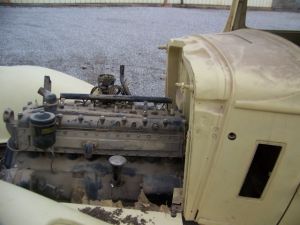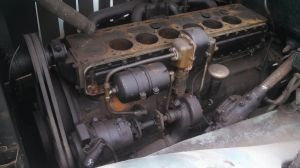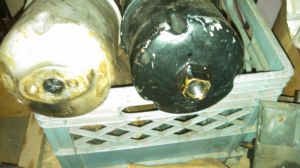- Home
- About Us
- Join/Renew
- Member Benefits
- Member Pages
- Log In
- Help
- Museum Store
I just wanted to know if the Pierce and the Studebaker 29-31 8 engines are the same engine….i was in a discussion with a friend and i did not know…Ed
They are not.
Bill Cannon wrote a very comprehensive article in the 1983 Antique Studebaker Review. I have a copy, but can’t attach it as it is a .pdf document, and also can’t find it searching the web. I will email you a copy.
The metal used in the Pierce engines is a superior grade. Has more chromium/nickle in it. My shop had to buy new cutting blades when they rebored it. Studebaker never used the same formula.
Just wondering about the physical dimensions of the Pierce 8. What are the length, width, height of the bare engine? Also the rough dry weight?
It is my understanding that some parts were interchangeable between
these engines. Studebaker set speed records with its straight eight. We
can only speculate about how much collaboration took place on the
straight eight under Studebaker’s ownership of Pierce-Arrow.
Depending on what year Studebaker engine you refer to, the engines can be very different, or similar enough to share the same cylinder head. However not all water passageways match up, and overheating can or will result.
The Studebaker President engine in ’32 and a few other years was similar to the Pierce 8, but while the cylinder head bolt pattern was the same, the cylinder head itself had a ‘domed’ look, with rounded surfaces, while the Pierce head had squared edges and sides. The difference is noticeable from 10 feet away.
The Studebaker head has a smaller combustion chamber, resulting in higher compression, so the Studebaker head was occasionally put on a Pierce engine as seen in the attached photo. But it just looks wrong, and careful matching of cooling passageways would be necessary.
The Studebaker engines other than the President engine were NOT 9 main bearing engines, and were smaller displacement.
I do not know physical external dimensions, I’ve never taken a tape measure to a Studebaker engine for comparison, so I can’t answer that question.
The Pierce 8 and Pierce 12 were very strong, overbuilt engines, that survived as Seagraves Fire Truck engines into the 1960’s, with very few modifications, the basic design stayed the same. Having a 40 year run as a production, truck and industrial engine speaks to the strength and integrity of the original design.
Greg Long
Photo of a ’33 836 engine, 3.5″x4.75″, 366 cubic inch displacement, this engine has hydraulic valve lifters. I do not know if Studebaker ever used zero-lash hydraulic lifters. This particular engine has the wrong oil filter type, this is a bypass filter, a correct ’33 engine not only has a full flow oil filter, but it also has an oil temperature regulator, an oil heater/cooler to keep the oil temperature and therefore the oil viscosity more stable for the proper operation of the hydraulic lifters.

This is a correct full-flow oil filter and oil temperature regulator on a ’33 Pierce engine.
Greg Long

The next issue of the PASB will reprint Bill Cannon’s 1983 article about interchange of Studebaker and Pierce 8-cylicnder parts.
Greg’s wonderful picture raises a couple of questions for me.
1. How on earth does that oil filter get ‘refreshed’? Is it flushed in place, or is this the predecessor to the ‘lifetime lubrication’ that we get now?
2. The cylinder spacing seems odd. With 9 mains, I would think the motor would have equal spacing. Did the water jacket go around pairs of cylinders?
Dean,
On your question #2, here is a picture of a crank out of a ’33, if that helps. It is covered in grease, that is why it looks so trashy. It is about 44″. All the thrust is taken off the first main which is on the right side of the photo.”
The cylinder spacing is slightly irregular, mainly because of the extra wide center main bearing. and the need for some space for the distributor drive and oil pump drive and piping.
The oil filter is a throw-away canister, with a 3/8″ NPT thread on each end.. This is why so many oil lines for these later engines are bent and twisted. It takes some finesse to hold and loosen or tighten the fittings, and it takes some odd tools for some instances. IE: custom made tools for your car. But in most cases good tools to do the odd angles and fittings are available from Snap-On, Mac, etc.
The filter is a Purolator L-4, I think. I need to check that.. There are L-4, L-6, and L-8 that I have had in my hands at times. the L-8 is for a Packard application and has a two-bolt flange and gasket on the oil lines instead of a NPT threaded fitting.
Photos to follow, later today IF I remember and find the time..
Greg Long
Presumably, those filters have right hand threads on one end and left hand on the other end. That is an interesting way to force the filter to be installed with flow in one direction.
Thanks for the other information (e.g. cranshaft length)
Don’t forget the filter lines need restriction………….THEY ARE NOT MADE TO BE RUN FULL FLOW FROM THE LINES! IF YOU DO YOU WILL BURN OUT YOUR BEARINGS IN TEN MINUTS.
Ed, a ’32 and earlier engine with a bypass oil filtration system uses a restriction in the oil line to the filter.
A ’33 and later engine has all the oil going through the oil filter, and then through the temperature regulator, then into the main oil gallery. A restriction in the lines on a ’33 and later engine would starve the bearings for lubrication and result in a trashed engine.
In a ’33 and later oil system, at the outlet of the full flow filter the ‘Tee’ runs to the temperature regulator, and the other direction is to a pressure controller, The pressure controller keeps oil being supplied to the engine bearings, unlike a bypass system with just an opening dumping the filtered oil back into the crankcase.
I’d check with John, ’33 and later oil lines do not have restrictions in them, that is why the lines are so large in diameter, so they can carry all the oil for the engine.
On ’32 and earlier engines, the bypass filter has small lines and a restriction in the system because the oils is ‘bled’ from the supply to the bearings.. And if a bypass system has no restriction, it could bleed off too much oil pressure and volume and the bearings would starve for lubrication.
In ’32 and earlier engines the main oil passageways are all internal in the crankcase, and the oil pressure regulator is built into the right front corner of the engine block.
Greg.
Two different animals,
Dean: the water jacket is the full length of the cylinder block, it is around 45″ long. All 8 of the cylinders are being cooled by the large volume of water surrounding them. the water then flows up through water passageways in the top of the block, into the cylinder head, and on to the radiator.
The full flow oil filter has NPT. threads. Pipe threads are tapered, so they seal as they are tightened into a fitting. If the threads in a pipe fitting are tapped [threaded] too deep, they are too large in diameter, and a pipe will go into the fitting very deep and not seal. OR if the pipe fitting is not tapped [threaded] deep enough, a pipe only have a few threads in the titting when they tighten up,
So with the above said, if a filter like is use on the ’33 and later engines had a left and a right hand threaded fitting, it would be difficult if not impossible to get a replacement filter to have the same identical thread depth, taper, and starting point on the threads.. What would result would be one fitting getting tight an sealing when the other end of the filter, the threads are still loose and would leak oil..
So, the Purolator oil filters have standard right hand NPT threads on each end, and the fittings when they are removed and transferred to a new replacement filter, are tightened independently, and positioned so that the oil lines will thread onto the flare fittings in their original positons. It is not a quick procedure like our modern spin-on oil filters.
Since these early Purolator filters are long out of production, an adapter and modification kit has been made to use the Purolator canisiter, and instal a modern full flow spin-on oil filter inside. So the exterior appearance is the same, but the canister is reused with each filter change.
The photo is of a Purolator L-8 on the left, this is for a Packard, using two bolts and a gasket to seal their oil line to the filter canister, the filter on the right is a Purolator L-4 I think, with the pipe threaded fitting on each end.
Greg Long

Greg is correct. My fault for not being more detailed in my answer and calling out the years of the early engine application I was posting about. John has made oil lines in the past, both 8 and 12. They are a big pain in the axx to get right. My 32 suffered an oil line failure on Rt 95 on the way to Rhode Island last year. Got lucky when John saw the oil pressure dumping and shut it down in time to save the motor. Using worked over lines (car came that way) can be an expensive lesson. Run new lines with proper support and fittings. Ed
Hi Ed, I did not know your Coupe had an oil line issue on the way to Warwick. I usually have some supplies with me in the trailer or truck, don’t be bashful, just ask, I might have something to repair the lines. I’m sure another made-up line was or could be made from supplies from a local NAPA autoparts store.
Yes, the big oil lines for the ’33 are a real pain, I can see why so many of the ’33 and later cars are missing all or part of the external plumbing.. and just have a loop of copper line from the oil exit port to the main gallery port? I’ve seen probably a dozen like this.
The worst example was a bright blue, two-tone ’36 Club Sedan that went up for auction at Auctions America three years ago, It might have been two years ago, not sure. Anyway, the oil filter, and oil temperature regulator were disconnected, and a piece of low-pressure RUBBER fuel HOSE was in between the two ports on the engine block. This fuel hose is rated for ? 20-30PSI, and not a high temp hose either.. I cannot imagine anyone putting such a weak piece of hose to conduct ALL the lubrication in an engine.. Maybe that line blew off in the past, since the car had abysmal oil pressure.
Glad you and John saw the oil pressure dropping and saved the engine.
Take care,
Greg Long
